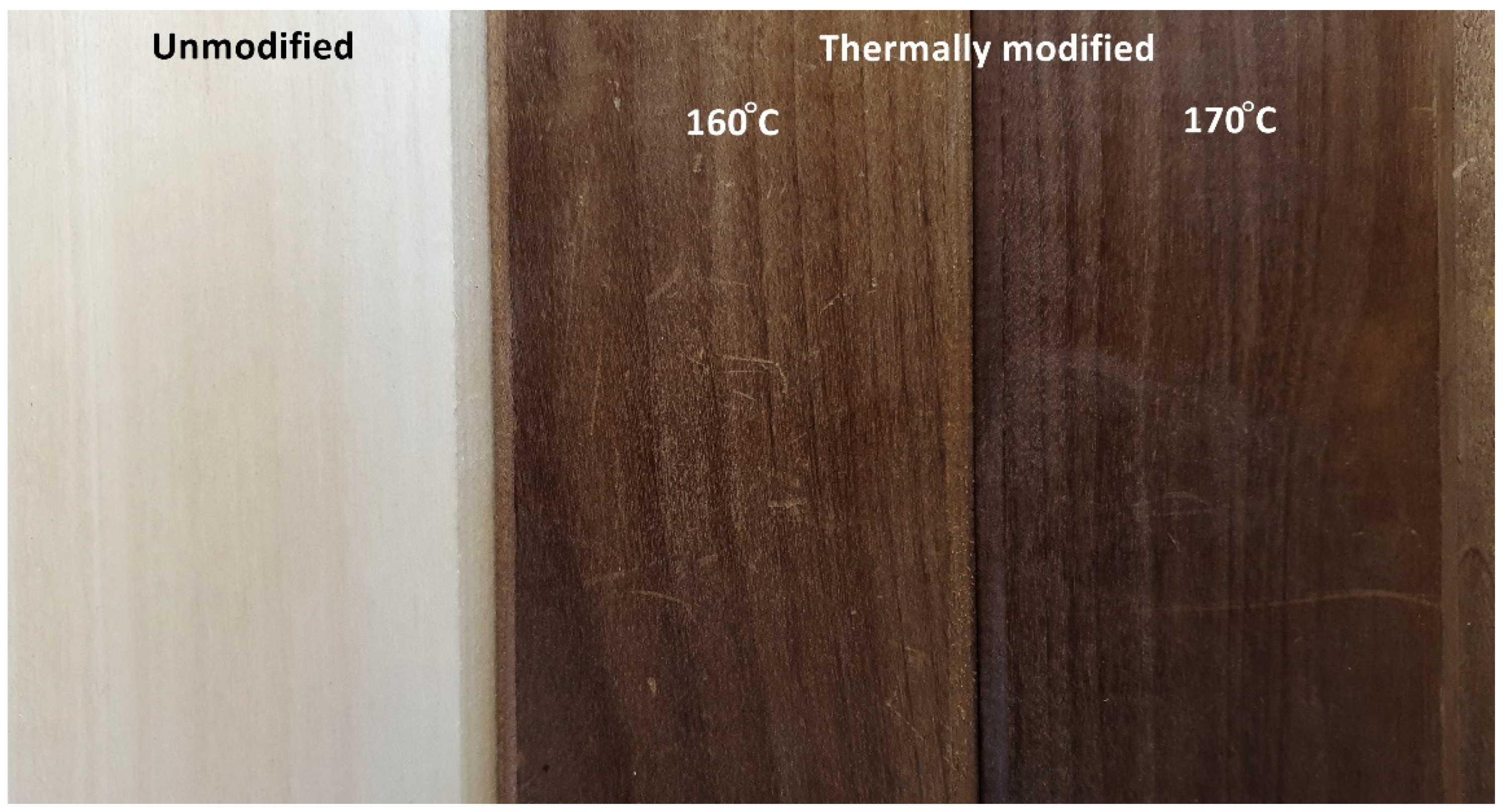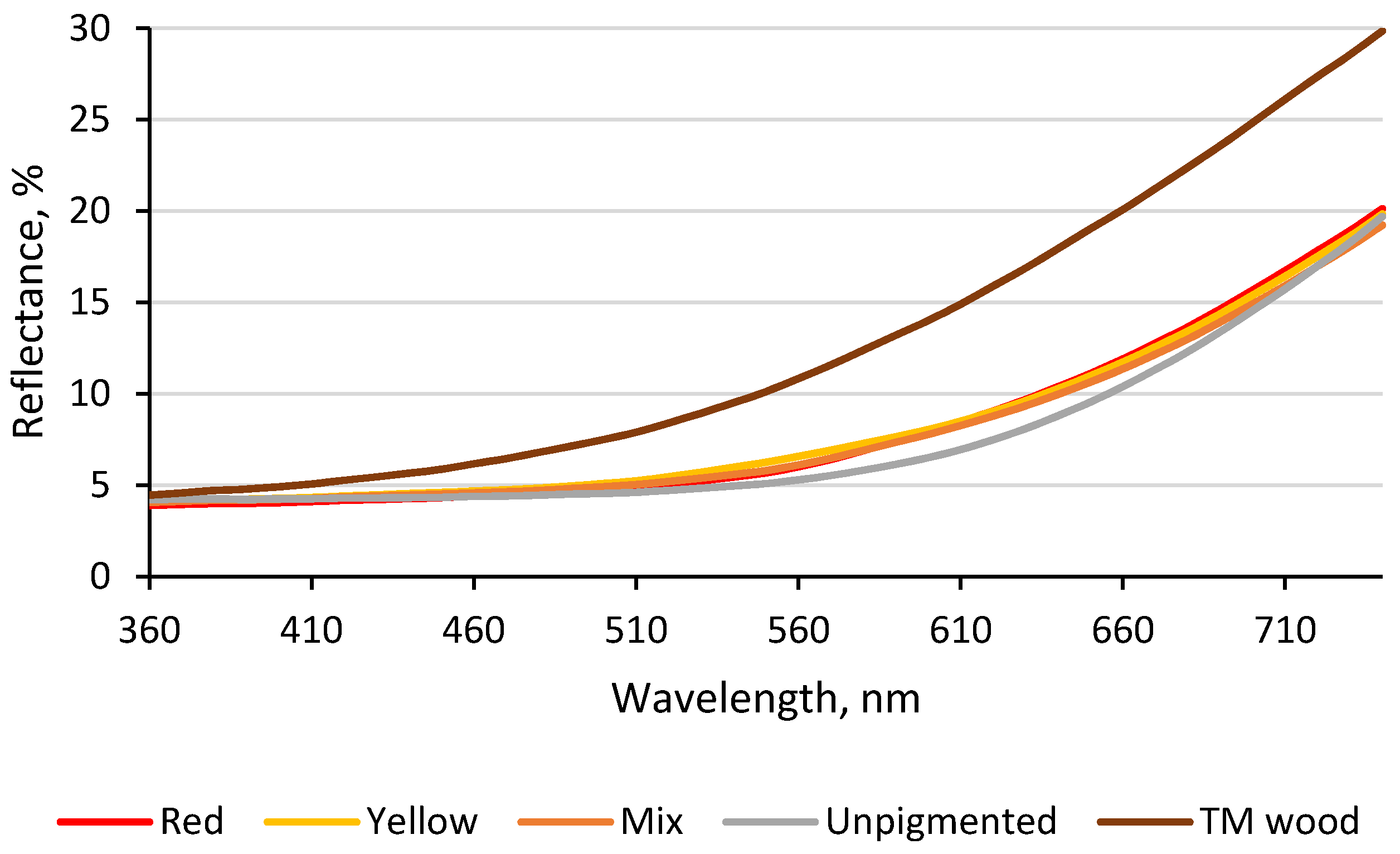Enhancing Thermally Modified Wood Stability against Discoloration
Abstract
:1. Introduction
2. Materials and Methods
2.1. Wood Material
2.2. Color and Reflectance Spectra Measurement
2.3. Coating Formulations and Finishing of Specimens
2.4. Weathering Experiments
3. Results and Discussion
3.1. TM Wood Color and Its Photosensitivity
3.2. Effect of Lignin Stabilizer
3.3. Effect of Incorporation of Pigments into Coating on TM Wood Color
3.4. Effect of Incorporation of a Light Stabilizer Additive into Pigmented Coating Formulation
3.5. Effect of Red and Yellow Iron Oxide Pigmenst in Coating Formulation on TM Wood Discoloration during Natural Weathering
4. Conclusions
Author Contributions
Funding
Institutional Review Board Statement
Informed Consent Statement
Data Availability Statement
Conflicts of Interest
References
- Hill, C.A.; Hill, S. Wood Modification: Chemical, Thermal, and Other Processes; John Wiley and Sons Ltd.: West Sussex, UK, 2006; pp. 99–127. [Google Scholar]
- Esteves, B.M.; Pereira, H.M. Wood modification by heat treatment: A review. BioResuorces 2009, 4, 370–404. [Google Scholar] [CrossRef]
- Militz, H.; Altgen, M. Processes and properties of thermally modified wood manufactured in Europe. Deterior. Prot. Sustain. Biomater. ACS Symp. Ser. 2014, 1158, 269–285. [Google Scholar] [CrossRef]
- Schnabel, T.; Zimmer, B.; Petutschnigg, A.J.; Schönberg, S. An approach to classify thermally modified hardwoods by color. For. Prod. J. 2007, 57, 105–110. [Google Scholar]
- Cirule, D.; Kuka, E. Effect of thermal modification on wood colour. Res. Rural Dev. 2015, 2, 87–92. [Google Scholar]
- Brischke, C.; Welzbacher, C.R.; Brandt, K.; Rapp, A.O. Quality control of thermally modified timber: Interrelationship between heat treatment intensities and CIE L*a*b* color data on homogenized wood samples. Holzforschung 2007, 61, 19–22. [Google Scholar] [CrossRef]
- Esteves, B.; Marques, A.V.; Domingos, I.; Pereira, H. Heat-induced colour changes of pine (Pinus pinaster) and eucalypt (Eucalyptus globulus) wood. Wood Sci. Technol. 2008, 42, 369–384. [Google Scholar] [CrossRef] [Green Version]
- Tuong, V.M.; Jian, L. Effect of heat treatment on the change in color and dimensional stability of acacia hybrid wood. BioResources 2010, 5, 1257–1267. [Google Scholar]
- Hon, D.N.S.; Minemura, N. Color and Discoloration. In Wood and Cellulosic Chemistry, 2nd ed.; Hon, D.N.S., Shiraishi, N., Eds.; Marcel Dekker: New York, NY, USA, 2000; pp. 385–442. [Google Scholar]
- Cogulet, A.; Blanchet, P.; Landry, V. The multifactorial aspect of wood weathering: A review based on holistic approach of wood degradation protected by clear coating. BioResources 2018, 13, 2116–2138. [Google Scholar] [CrossRef] [Green Version]
- Kropat, M.; Hubbe, M.A.; Laleicke, F. Natural, accelerated, and simulated weathering of wood: A review. Bioresources 2020, 15, 9998–10062. [Google Scholar]
- Nuopponen, M.; Wikberg, H.; Vuorinen, T.; Maunu, S.L.; Jämsä, S.; Viitaniemi, P. Heat-treated softwood exposed to weathering. J. Appl. Polym. Sci. 2004, 91, 2128–2134. [Google Scholar] [CrossRef]
- Yildiz, S.; Yildiz, U.C.; Tomak, E.D. The effects of natural weathering on the properties of heat-treated alder wood. BioResources 2011, 6, 2504–2521. [Google Scholar] [CrossRef]
- Metsä-Kortelainen, S.; Paajanen, L.; Viitanen, H. Durability of thermally modified Norway spruce and Scots pine in above-ground conditions. Wood Mater. Sci. Eng. 2011, 6, 163–169. [Google Scholar] [CrossRef]
- Auclair, N.; Riedl, B.; Blanchard, V.; Blanchet, P. Improvement of photoprotection of wood coatings by using inorganic nanoparticles as ultraviolet absorbers. For. Prod. J. 2011, 61, 20–27. [Google Scholar] [CrossRef]
- Evans, P.D.; Haase, J.G.; Shakri, A.; Seman, B.M.; Kiguchi, M. The search for durable exterior clear coatings for wood. Coatings 2015, 5, 830–864. [Google Scholar] [CrossRef] [Green Version]
- Reinprecht, L.; Tiňo, R.; Šomšák, M. Impact of fungicides, plasma, UV-additives and weathering on the adhesion strength of acrylic and alkyd coatings to the Norway spruce wood. Coatings 2020, 10, 1111. [Google Scholar] [CrossRef]
- Evans, P.D.; Chowdhury, M.J.; Mathews, B.; Schmalzl, K.; Ayer, S.; Kiguchi, M.; Kataoka, Y. Weathering and surface protection of wood. In Handbook of Environmental Degradation of Materials; Myer, K., Ed.; William Andrew Publishing: Norwich, NY, USA, 2005; pp. 277–297. [Google Scholar]
- Shenoy, M.A.; Marathe, Y.D. Studies on synergistic effect of UV absorbers and hindered amine light stabilisers. Pigment Resin Technol. 2007, 36, 83–89. [Google Scholar] [CrossRef]
- Forsthuber, B.; Grüll, G. The effects of HALS in the prevention of photo-degradation of acrylic clear topcoats and wooden surfaces. Polym. Degrad. Stab. 2010, 95, 746–755. [Google Scholar] [CrossRef]
- Aloui, F.; Ahajji, A.; Irmouli, Y.; George, B.; Charrier, B.; Merlin, A. Inorganic UV absorbers for the photostabilisation of wood-clearcoating systems: Comparison with organic UV absorbers. Appl. Surf. Sci. 2007, 253, 3737–3745. [Google Scholar] [CrossRef]
- Schaller, C.; Rogez, D.; Braig, A. Organic vs inorganic light stabilizers for waterborne clear coats: A fair comparison. J. Coat. Technol. Res. 2012, 9, 433–441. [Google Scholar] [CrossRef]
- Schaller, C.; Rogez, D. New approaches in wood coating stabilization. J. Coat. Technol. Res. 2007, 4, 401–409. [Google Scholar] [CrossRef]
- Blanchard, V.; Blanchet, P. Color stability for wood products during use: Effects of inorganic nanoparticles. BioResources 2011, 6, 1219–1229. [Google Scholar]
- Schauwecker, C.F.; McDonald, A.G.; Preston, A.F.; Morrell, J.J. Use of iron oxides to influence the weathering characteristics of wood surfaces: A systematic survey of particle size, crystal shape and concentration. Eur. J. Wood Prod. 2014, 72, 669–680. [Google Scholar] [CrossRef]
- Jämsä, S.; Ahola, P.; Viitaniemi, P. Long-term natural weathering of coated Thermo Wood. Pigment Resin Technol. 2000, 29, 68–74. [Google Scholar] [CrossRef]
- Altgen, M.; Militz, H. Thermally modified Scots pine and Norway spruce wood as substrate for coating systems. Coat. Technol. Res. 2017, 14, 531–541. [Google Scholar] [CrossRef]
- Nejad, M.; Dadbin, M.; Cooper, P. Coating Performance on exterior oil-heat treated wood. Coatings 2019, 9, 225. [Google Scholar] [CrossRef] [Green Version]
- Jirouš-Rajković, V.; Miklečić, J. Heat-treated wood as a substrate for coatings, weathering of heat-treated wood, and coating performance on heat-treated wood. Adv. Mater. Sci. Eng. 2019, 2019, 8621486. [Google Scholar] [CrossRef] [Green Version]
- Saha, S.; Kocaefe, D.; Boluk, Y.; Pichette, A. Enhancing exterior durability of jack pine by photo-stabilization of acrylic polyurethane coating using bark extract. Part 1: Effect of UV on color change and ATR-FT-IR analysis. Prog. Org. Coat. 2011, 70, 376–382. [Google Scholar] [CrossRef]
- Saha, S.; Kocaefe, D.; Sarkar, D.K.; Boluk, Y.; Pichette, A. Effect of TiO2-containing nano-coatings on the color protection of heat-treated jack pine. J. Coat. Technol. Res. 2011, 8, 183–190. [Google Scholar] [CrossRef]
- Miklečić, J.; Turkulin, H.; Jirouš-Rajković, V. Weathering performance of surface of thermally modified wood finished with nanoparticles-modified waterborne polyacrylate coatings. Appl. Surf. Sci. 2017, 408, 103–109. [Google Scholar] [CrossRef]
- Shen, H.; Zhang, S.; Cao, J.; Jiang, J.; Wang, W. Improving anti-weathering performance of thermally modified wood by TiO2 sol or/and paraffin emulsion. Constr. Build. Mater. 2018, 169, 372–378. [Google Scholar] [CrossRef]
- Chen, Y.; Fan, Y.; Gao, J.; Stark, N.M. The effect of heat treatment on the chemical and color change of black locust (Robinia pseudoacacia) wood flour. BioResources 2012, 7, 1157–1170. [Google Scholar] [CrossRef]
- Yao, C.; Yongming, F.; Jianmin, G.; Houkun, L. Coloring characteristics of in situ lignin during heat treatment. Wood Sci. Technol. 2012, 46, 33–40. [Google Scholar] [CrossRef]
- Tolvaj, L.; Faix, O. Artificial ageing of wood monitored by DRIFT spectroscopy and CIE L*a*b* color measurenments. Holzforschung 1995, 49, 397–404. [Google Scholar] [CrossRef]
- Ayadi, N.; Lejeune, F.; Charrier, F.; Charrier, B.; Merlin, A. Color stability of heat-treated wood during artificial weathering. Holz Roh Werkst 2003, 61, 221–226. [Google Scholar] [CrossRef]
- Deka, M.; Humar, M.; Rep, G.; Kričej, B.; Šentjurc, M.; Petrič, M. Effects of UV light irradiation on colour stability of thermally modified, copper ethanolamine treated and non-modified wood: EPR and DRIFT spectroscopic studies. Wood Sci. Technol. 2008, 42, 5–20. [Google Scholar] [CrossRef]
- Miklečić, J.; Jirouš-Rajković, V.; Antonović, A.; Španić, N. Discolouration of thermally modified wood during simulated indoor sunlight exposure. BioResources 2011, 6, 434–446. [Google Scholar] [CrossRef]
- Tolvaj, L.; Nemeth, R.; Pasztory, Z.; Bejo, L.; Takats, P. Colour stability of thermally modified wood during short-term photodegradation. BioResources 2014, 9, 6644–6651. [Google Scholar] [CrossRef] [Green Version]
- Li, X.; Li, T.; Li, G.; Lu, Q.; Qin, S.; Li, J. Effect of UV light irradiation on color changes in thermally modified rubber wood based on FTIR. BioResources 2020, 15, 5179–5197. [Google Scholar]
- George, B.; Suttie, E.; Merlin, A.; Deglise, X. Photodegradation and photostabilisation of wood—The state of the art. Polym. Degrad. Stab. 2005, 88, 268–274. [Google Scholar] [CrossRef]
- Evans, P.D. Weathering of wood and wood composites. In Handbook of Wood Chemistry and Wood Composites, 2nd ed.; Rowell, R.M., Ed.; CRC Press: Boca Raton, FL, USA, 2013; pp. 151–216. [Google Scholar]
- Huang, X.; Kocaefe, D.; Kocaefe, Y.; Boluk, Y.; Pichette, A. A spectrocolorimetric and chemical study on color modification of heat-treated wood during artificial weathering. Appl. Surf. Sci. 2012, 258, 5360–5369. [Google Scholar] [CrossRef]
- Huang, X.; Kocaefe, D.; Kocaefe, Y.; Boluk, Y.; Pichette, A. Study of the degradation agents of heat-treated jack pine (Pinus banksiana) under artificial sunlight irradiation. Polym. Degrad. Stab. 2012, 97, 1197–1214. [Google Scholar] [CrossRef]
- Srinivas, K.; Pandey, K.K. Photodegradation of thermally modified wood. J. Photochem. Photobiol. B 2012, 117, 140–145. [Google Scholar] [CrossRef]
- Zayat, M.; Garcia-Parejo, P.; Levy, D. Preventing UV-light damage of light sensitive materials using a highly protective UV-absorbing coating. Chem. Soc. Rev. 2007, 36, 1270–1281. [Google Scholar] [CrossRef]
- Sivonen, H.; Maunu, S.L.; Sundholm, F.; Jämsä, S.; Viitaniemi, P. Magnetic resonance studies of thermally modified wood. Holzforschung 2002, 56, 648–654. [Google Scholar] [CrossRef]
- Kocaefe, D.; Saha, S. Comparison of the protection effectiveness of acrylic polyurethane coatings containing bark extracts on three heat-treated North American wood species: Surface degradation. Appl. Surf. Sci. 2012, 258, 5283–5290. [Google Scholar] [CrossRef]
- Hayashi, K. Practical issue of nanosized colorant particles. In Nanoparticle Technology Handbook, 3rd ed.; Naito, M., Yokoyama, T., Hosokawa, K., Nogi, K., Eds.; Elsevier: Amsterdam, The Netherlands, 2018; pp. 607–612. [Google Scholar]
- Feist, W.C. Role of pigment concentration in the weathering of semitransparent stains. For. Prod. J. 1988, 38, 41–44. [Google Scholar]







Publisher’s Note: MDPI stays neutral with regard to jurisdictional claims in published maps and institutional affiliations. |
© 2021 by the authors. Licensee MDPI, Basel, Switzerland. This article is an open access article distributed under the terms and conditions of the Creative Commons Attribution (CC BY) license (http://creativecommons.org/licenses/by/4.0/).
Share and Cite
Cirule, D.; Sansonetti, E.; Andersone, I.; Kuka, E.; Andersons, B. Enhancing Thermally Modified Wood Stability against Discoloration. Coatings 2021, 11, 81. https://doi.org/10.3390/coatings11010081
Cirule D, Sansonetti E, Andersone I, Kuka E, Andersons B. Enhancing Thermally Modified Wood Stability against Discoloration. Coatings. 2021; 11(1):81. https://doi.org/10.3390/coatings11010081
Chicago/Turabian StyleCirule, Dace, Errj Sansonetti, Ingeborga Andersone, Edgars Kuka, and Bruno Andersons. 2021. "Enhancing Thermally Modified Wood Stability against Discoloration" Coatings 11, no. 1: 81. https://doi.org/10.3390/coatings11010081
APA StyleCirule, D., Sansonetti, E., Andersone, I., Kuka, E., & Andersons, B. (2021). Enhancing Thermally Modified Wood Stability against Discoloration. Coatings, 11(1), 81. https://doi.org/10.3390/coatings11010081




